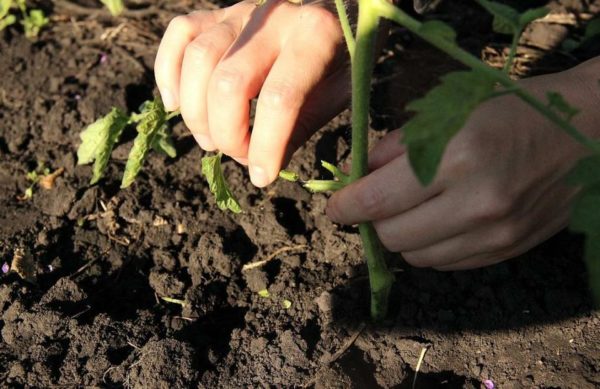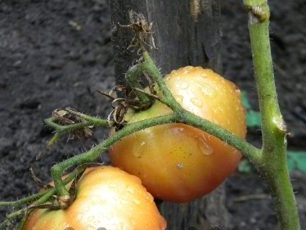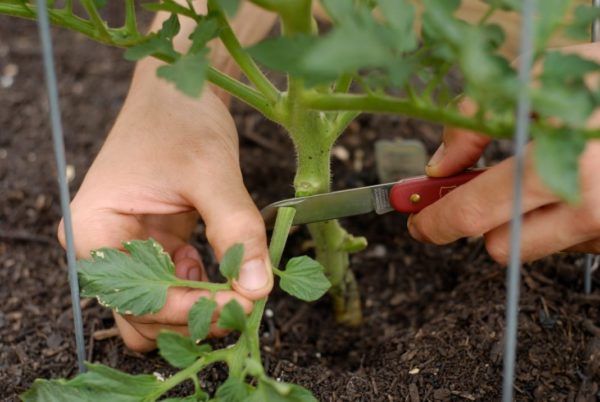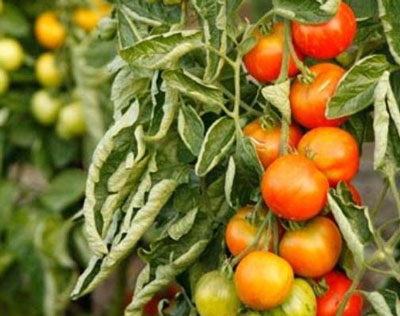Tomato leaves are the plant’s most important organ, along with stems and roots. Without green mass, the process of photosynthesis will be disrupted, the bushes will cease to bloom, become depleted and will soon dry out. At the same time, excess foliage obscures the fruits, interferes with the normal blowing of the bush, creates ideal conditions for the development of viruses, fungi and attacks on tomato pests. Find out if you need to pick leaves from tomatoes in open ground and a greenhouse, why, when and how to do it.
Why and what leaves need to be removed
The opinion that tomato bushes from the time of planting to autumn is better not to disturb the pruning of leaves is inherent to beginners. Experienced gardeners describe a lot of the benefits of a haircut, call the procedure mandatory, along with pinching. In open ground, tomato cutting should be carried out carefully, making sure that the fruits are not completely exposed and do not receive sunburn. In the greenhouse, the bushes are already protected from direct sunlight. In any growing conditions, greens are harvested gradually, from bottom to top.

The lowest leaves that touch the soil are removed first, after watering they begin to rot, infection foci are formed, which leads to the development of late blight and other diseases. Especially dangerous are the lower yellowed plates, possibly even with dark spots, they must be removed immediately. In addition to the lower, healthy or yellowed leaves, it is advisable to remove dried specimens, it does not matter in which part of the bush they are located. Thinning of the crown contributes to ventilation, but in this case it is advisable to remove the leaves from the north side and only those that look inside the bush will thicken it. We highlight the advantages of cutting a tomato:
- When the leaves are torn off, the bush becomes open, normal air exchange ensures rapid evaporation of moisture from the top layer of the earth and the plant itself. The risk of diseases and pests is minimized.
- Aged, sunburned and infected leaves can dry out. In the first two cases, they are no longer needed, as they take away nutrients until they are completely dry. If dry areas on the plates appeared due to diseases or insects, then their timely removal will prevent the spread of ailments to healthy tomatoes.
- When removing excess vegetative mass, the need for tomato in frequent watering decreases, moisture consumption decreases. Food and water go to the development of the fruit.
 You may be interested in:
You may be interested in:Sun-burned plates, if the bush needs them (cover the brushes), can not be completely cut off, but only half. It turns out that not only wilted or yellowed leaves are subject to removal, but also healthy ones. Massive greens cause many problems, complicate the process of care and harvesting, and the quality and quantity of the crop is reduced. Additional fertilizer application and more frequent watering will not help save the situation, but will only aggravate it.
Tomato pruning rules
For the procedure, prepare a sharp, sanitized garden tool (knife, scissors or pruner). You need to clean the tool after trimming each bush of a tomato. Leaves can not be cut, but cut off. Petiole is pressed tightly at the base, pulled up (along the stem).In order not to damage or break off the trunk, it is supported, the sheet is pulled sharply, but without any effort. The petiole cannot be pulled down; together with its base, the skin of the stem often leaves; the resulting wound will be the gateway to dangerous infections.

You can’t rush to cut the tomatoes, when cutting immediately after transplanting the seedlings, the plants may stop developing, you need to wait until the tomatoes have fully taken root (10-15 days). The fact that the bushes are stronger can be judged by their active growth. Before starting the procedure, you should carefully examine the tomatoes, first remove the lower leaves that have begun to turn yellow or dry, then those that have fallen to the ground.
If you are not sure whether to remove healthy lower leaves, remove those located on the north side of the plant, since they are practically not responsible for photosynthesis (they are in the shade), their removal will not do any harm. When pruning, watch the bushes, sometimes the process provokes the development of new inflorescences, it is advisable to leave them only if the bush has not bloomed well before. If there are a lot of buds and ovaries, the nascent brushes are removed.
In the greenhouse, tall tomatoes lead in 1 or 2 stems, while planting should be well ventilated. Indoors, the air circulates poorly and becomes excessively humid. Such an environment provokes the development of fungal and viral diseases, so the leaves are removed necessarily, and not like in the open ground. How to cut tomatoes so as not to harm the bush, in different growing conditions, we will describe in the table.
| Open ground | Greenhouse |
|
The procedure can be performed on a sunny day and only before lunch. After removing the leaves, the wounds should heal as quickly as possible. |
Cutting leaves is permissible at any time of the day, but on the day of the procedure, skip the greenhouse ventilation session. |
|
Mowing should be done once a week, no more than 2-3 leaves can be removed at a time, if more greenery is cut off, the bush will experience stress, which will negatively affect the size and taste of the fruit. |
The pruning frequency is the same as in the case with open ground, but it is permissible to remove 5-6 leaves per day. |
|
Leaves must be left on the bushes to shade the fruit from the sun. |
After the formation of the ovaries on all hands, a complete pruning of leaves is possible, except for a small bunch at the top of the stem. After pinching the growth point (approximately in mid-August), no more than 4 leaves should be left on the top of the head for normal sap flow. |
In order not to get confused in the timing, carry out the first wave of pruning after all the ovaries are formed in the lowest inflorescence. The second wave is when the tomatoes are fully formed. Thus, the maximum amount of nutrients you send to the fruits. After removing leaves, watering should be reduced, excess moisture can cause cracking of the tomato. If it rains, there is no need for additional moistening, you often need to loosen the soil at the base of the stem so that the water evaporates faster and does not stagnate.
 You may be interested in:
You may be interested in:Reviews
Catherine
There is no doubt about the advisability of pruning tomatoes, the procedure is important for the normal development of the fruit. It is usually recommended to remove no more than 3 leaves at a time, I violate this rule, often remove 5 or 6, even in open ground.Much depends on the amount of green mass, if it interferes with the plant, why leave it? I did not notice that the bushes somehow suffered after a strong pruning. If you have to remove too many leaves due to bush disease, I put pegs in the open ground, fit them with a special net so that the fruits do not have sunburn.
Valery
In indeterminate tomatoes that are planted in a greenhouse by the time of pinching, the trunk to the upper inflorescence is completely naked. In the open ground I leave part of the greenery - under the brushes and above them 2 or 3 leaves, sometimes I cut them in half. I see that there is less vegetative mass on the north side of the bush than on the rest. Determinant tomatoes sometimes also cut, but for thinning. I always act according to this rule - if all the ovaries have formed in the brush, I remove the lower leaves. When a couple of flowers have not yet been set in the brush, I do not touch the leaves under this inflorescence.
Whoever says that, removing leaves from tomatoes is a necessary procedure aimed at preventing diseases and obtaining better fruits. The main thing is to follow the rules described and not to rush. After each pruning, all plant debris must be removed from the beds. As a mulch, it is undesirable to use even healthy leaves, since scoops and other insects can lay eggs in them. Leaves untouched by fungi or viruses can be composted, burned or prepared to spray other plants against aphids, Colorado potato beetles, sawflies, leaf-eating caterpillars and spider mites.

 Low-growing tomatoes, without pinching: 5 of the most delicious varieties
Low-growing tomatoes, without pinching: 5 of the most delicious varieties Why tomato seedlings grow poorly
Why tomato seedlings grow poorly We grow a tomato in a shell
We grow a tomato in a shell Growing tomatoes without watering according to the method of Kazarin
Growing tomatoes without watering according to the method of Kazarin